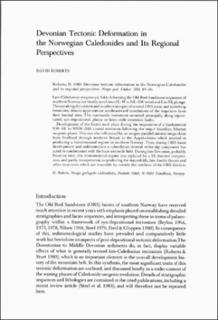Devonian tectonic deformation in the Norwegian Caledonides and its regional perspectives.
Journal article

Åpne
Permanent lenke
https://hdl.handle.net/11250/2675144Utgivelsesdato
1983Metadata
Vis full innførselSamlinger
- Artikler [1064]
Sammendrag
Late-Caledonian megascopic folds deforming the Old Red Sandstone sequences of southern Norway are mostly synclines of E-W to NE-SW trend and E to NE plunge. Thrusts along the eastern and southern margins of several ORS areas, and stretching lineations, denote approximate southeastward translation of the sequence from their basinal sites. This contractile movement occurred principally along rejuvenated, syn-depositional, planar or listric-style extension faults. Development of basins took place during the imposition of a fundamental NW-SE to NNW-SSE crustal extension following the major Scandian, Silurian orogenic phase. This was also influenced by an orogen-parallel sinistral mega-shear from Svalbard through northern Britain to the Appalachians which assisted in producing a transtensional regime in southern Norway. Thus, during ORS basin development and sedimentation a subordinate dextral strike-slip component has acted in combination with the basic extensile field. During late Devonian, probably Frasnian time, this transtensional regime was replaced by a SE-directed compression, and partly transpression, so producing the macrofolds, late ductile thrusts and other structures which are traceable far outside the confines of the ORS districts.
